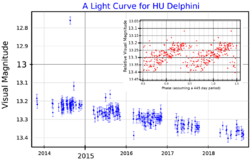Astronomy:HU Delphini
 A visual band light curve for HU Delphini, plotted from ASAS-SN data.[1] The main plot shows the long-term variability, and the inset plot shows the periodic variability. | |
| Observation data Equinox J2000.0]] (ICRS) | |
|---|---|
| Constellation | Delphinus |
| Right ascension | 20h 29m 48.344s[2] |
| Declination | +09° 41′ 20.25″[2] |
| Apparent magnitude (V) | 13.07[3] |
| Characteristics | |
| Spectral type | M4.5V[4] |
| U−B color index | +1.29[5] |
| B−V color index | +1.64[5] |
| Variable type | Flare star[6] |
| Astrometry | |
| Radial velocity (Rv) | -34.24 ± 0.07[3] km/s |
| Proper motion (μ) | RA: 673.1[3] mas/yr Dec.: 122.0[3] mas/yr |
| Parallax (π) | 113.4 ± 0.2[3] mas |
| Distance | 28.76 ± 0.05 ly (8.82 ± 0.02 pc) |
| Absolute magnitude (MV) | 13.46 / 16.73[3] |
| Orbit[3] | |
| Period (P) | 538.6 ± 0.1 d |
| Semi-major axis (a) | 0.1037 ± 0.0005″ |
| Eccentricity (e) | 0.558 ± 0.005 |
| Inclination (i) | 145.4 ± 0.6° |
| Longitude of the node (Ω) | 102.2 ± 1.1° |
| Periastron epoch (T) | JD 2451022.7 ± 0.9 |
| Argument of periastron (ω) (secondary) | 12.2 ± 1.5° |
| Semi-amplitude (K1) (primary) | 4.09 ± 0.08 km/s |
| Semi-amplitude (K2) (secondary) | 8.54 ± 0.13 km/s |
| Details[3] | |
| HU Del A | |
| Mass | 0.237 ± 0.004 M☉ |
| Metallicity [Fe/H] | 0.07 dex |
| Rotation | 0.3085±0.0005[7] |
| Rotational velocity (v sin i) | 35.1±0.2[7] km/s |
| HU Del B | |
| Mass | 0.114 ± 0.002 M☉ |
| Other designations | |
| Database references | |
| SIMBAD | data |
| ARICNS | A |
| B | |
HU Delphini, also known as Gliese 791.2, is a star system in the constellation of Delphinus. Its apparent magnitude is 13.07.[3] With a trigonometric parallax of 113.4 ± 0.2 mas,[3] it is about 28.76 light-years (8.82 parsecs) away from the Solar System.
HU Delphini is a binary star with a well-defined period of 538.6 days. The orbit has been derived from astrometry as well as through spectral observations, although that has been difficult because of the high projected rotational velocity. It is also fairly eccentric, at 0.558.[3]
Both stars in the system are red dwarfs. The primary component of the system is only 23.7% as massive as the Sun,[3] so it is fully convective.[4] As a result, there are frequent starspots on its surface, especially near poles.[7] While the normal surface temperature of the primary is 3000 K, the starspots themselves are cooler: only 2700 K. It is also a flare star,[4] the first flare been detected in August 2000.[8] The secondary star has a mass of 11.4% that of the Sun.[3]
See also
References
- ↑ "ASASSN-V J202948.39+094121.2 / HU Del". All Sky Automated Survey for SuperNovae. https://asas-sn.osu.edu/variables/ef24d96a-fdaa-5337-bdc0-7ed249970f91.
- ↑ 2.0 2.1 Cutri, Roc M.; Skrutskie, Michael F.; Van Dyk, Schuyler D.; Beichman, Charles A.; Carpenter, John M.; Chester, Thomas; Cambresy, Laurent; Evans, Tracey E. et al. (2003). "VizieR Online Data Catalog: 2MASS All-Sky Catalog of Point Sources (Cutri+ 2003)". CDS/ADC Collection of Electronic Catalogues 2246: II/246. Bibcode: 2003yCat.2246....0C. http://vizier.u-strasbg.fr/viz-bin/VizieR?-source=II/246.
- ↑ 3.00 3.01 3.02 3.03 3.04 3.05 3.06 3.07 3.08 3.09 3.10 3.11 3.12 Benedict, G. F.; Henry, T. J.; Franz, O. G.; McArthur, B. E.; Wasserman, L. H.; Jao, Wei-Chun; Cargile, P. A.; Dieterich, S. B. et al. (2016). "The Solar Neighborhood. XXXVII. The Mass–Luminosity Relation for Main-Sequence M Dwarfs". The Astronomical Journal 152 (5): 141. doi:10.3847/0004-6256/152/5/141. Bibcode: 2016AJ....152..141B.
- ↑ 4.0 4.1 4.2 Barnes, J. R.; Jeffers, S. V.; Jones, H. R. A.; Pavlenko, Ya. V.; Jenkins, J. S.; Haswell, C. A.; Lohr, M. E. (2015). "Starspot Distributions on Fully Convective M Dwarfs: Implications for Radial Velocity Planet Searches". The Astrophysical Journal 812 (1): 42. doi:10.1088/0004-637X/812/1/42. Bibcode: 2015ApJ...812...42B.
- ↑ 5.0 5.1 Nicolet, B. (1978). "Photoelectric photometric Catalogue of homogeneous measurements in the UBV System". Astronomy and Astrophysics Supplement Series 34: 1–49. Bibcode: 1978A&AS...34....1N.
- ↑ 6.0 6.1 "GJ 791.2". SIMBAD. Centre de données astronomiques de Strasbourg. http://simbad.u-strasbg.fr/simbad/sim-basic?Ident=GJ+791.2.
- ↑ 7.0 7.1 7.2 Barnes, J. R.; Jeffers, S. V.; Haswell, C. A.; Jones, H. R. A.; Shulyak, D.; Pavlenko, Ya. V.; Jenkins, J. S. (2017), "Surprisingly different star-spot distributions on the near equal-mass equal-rotation-rate stars in the M dwarf binary GJ 65 AB", Monthly Notices of the Royal Astronomical Society 471: 811–823, doi:10.1093/mnras/stx1482
- ↑ Natsvlishvili R. Sh., Karapetian A. A. A possible flare of a red dwarf HU Del
 |

